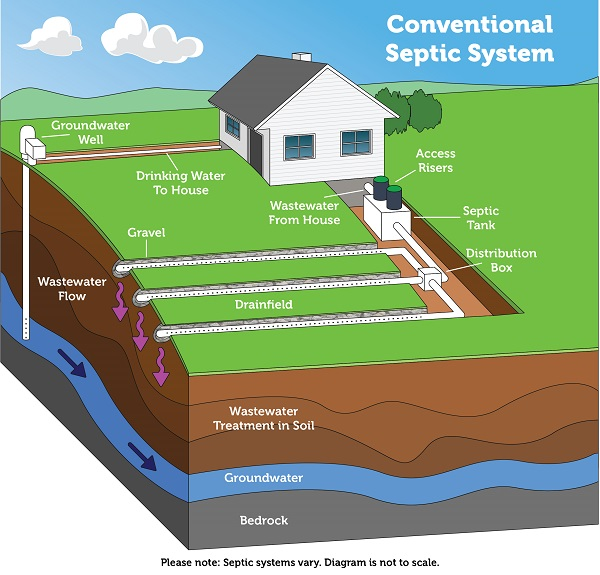
a conventional septic system collects waste in a septic tank where solids and fats are trapped, while liquids flow out to a drainfield for bacterial decomposition
Source: Environmental Protection Agency (EPA), Types of Septic Systems

a conventional septic system collects waste in a septic tank where solids and fats are trapped, while liquids flow out to a drainfield for bacterial decomposition
Source: Environmental Protection Agency (EPA), Types of Septic Systems
Liquid waste from houses can be processed by an onsite sewage disposal system using a septic tank and a leach field, which is also known as a drainfield. Septic tanks were invented by Louis M. Mouras in France in 1860. He added a sealed concrete tank between his house and a cesspool. Solids were deposited in the tank while liquids flowed on to the cesspool.
After ten years, Mouras opened the tank and discovered it was nearly empty. He realized that microbes were digesting the solids in the waste and patented his invention. The term "septic tank" was created by Donald Cameron in England in 1895. He installed a 53,000 gallon tank, 65' x 19', in which anaerobic bacteria processed the organic material for a portion of the town of Exeter.
At the time, there were no drainfields. Liquids which left a septic tank flowed into cesspools for evaporation, or into a nearby stream. The benefit of the septic tank was that the solids were removed by bacteria, improving the quality of the wastewater. As described by Cameron:1
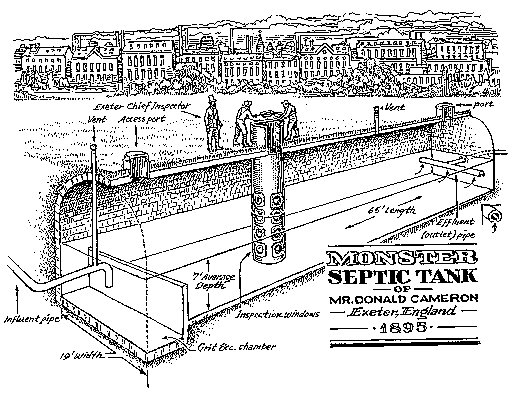
septic tanks were installed without drainfields in the 1800's
Source: University of Leeds, The "Monster Septic Tank"
Today, septic systems are most common in rural areas, where residential density is too low to make it cost-effective to install sewer pipes connecting to a central wastewater treatment plant. In urban areas and higher-density subdivisions, such as places with four dwelling units or more per acre, there is not sufficient space for drainfields to be separated from building foundations.
In a conventional septic system, solids flushed down a toilet or kitchen sink are trapped in a septic tank, along with grease and fats (scum). The tank has enough capacity to store wastewater for two-three days, during which solids accumulate on the bottom and grease/fats rise to a layer of scum on the top. A pipe leading out of the tank to the drainfield is located in the middle of the three layers, so scum and solids stay in the tank.
The tank's capacity to store effluent ensures that just liquid flows gradually into the drainfield pipes, mitigating the surges that occur when toilets are flushed or showers taken.
Liquids flow through the septic tank into underground drainfield pipes. The drainfield pipes are perforated with small holes, so the liquid escapes slowly. The pipes are laid in shallow (two-three feet deep) trenches filled with stone or gravel, which facilitates the flow of liquid out of the holes in the pipes by gravity. Multiple lines of pipes are buried, and in a conventional system each line must be no longer than 100 feet in length. A distribution box may be used to spread flow evenly among the pipes, and a pump may be used to force the effluent from the septic tank to a drainfield at a higher elevation.2
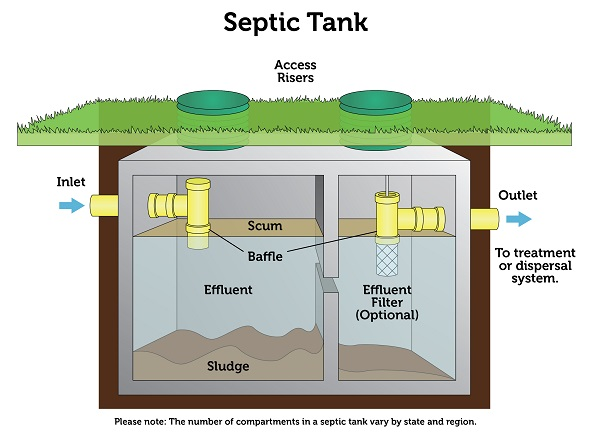
septic tanks gradually fill with solid waste, so they must be pumped out to ensure continued separation of solids, liquids, and grease/fats
Source: Environmental Protection Agency (EPA), Types of Septic Systems
Anaerobic bacteria which thrive without oxygen and then aerobic bacteria gradually decompose organic material in the liquid waste. Septic tanks are anaerobic unless a special design is used, but retention time of liquid in a septic tank is very brief. Bacterial activity in a septic tank is largely decomposition of the trapped solids, with minimal impact on the liquid that flows into the drainfield pipes.
Clog-eliminating drain cleaning chemicals such as Drano are not safe to use in a house with a septic system. The harsh, high-pH chemicals kill the healthy bacteria in the septic tank and drainfield that are required to decompose organics in wastewater.
Additives such as bacteria, enzymes, or chemical degreasers are advertised to enhance septic systems. When flushed into the septic tank, the enzymes and chemical degreasers have little time to affect even the top of the pile of compressed sediment in the tank before getting flushed into the drainfield pipes. The added bacteria end up as just extra food for the full complement of more-competitive bacteria already in the tank. Additives do little harm, but rarely increase decomposition in any significant way.
Sludge accumulates in a tank, so the material must be pumped out in order to retain adequate space for the liquid. State law requires pumping septic tanks located in Chesapeake Bay Preservation Areas every five years.3
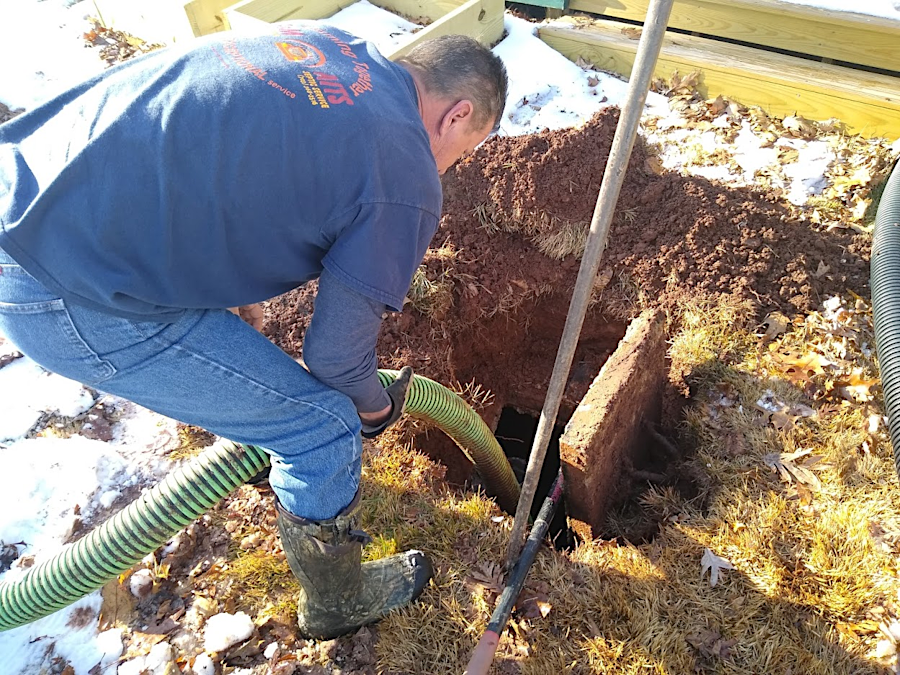
solid waste and fats/oils accumulate in septic tanks, and must be pumped out regularly
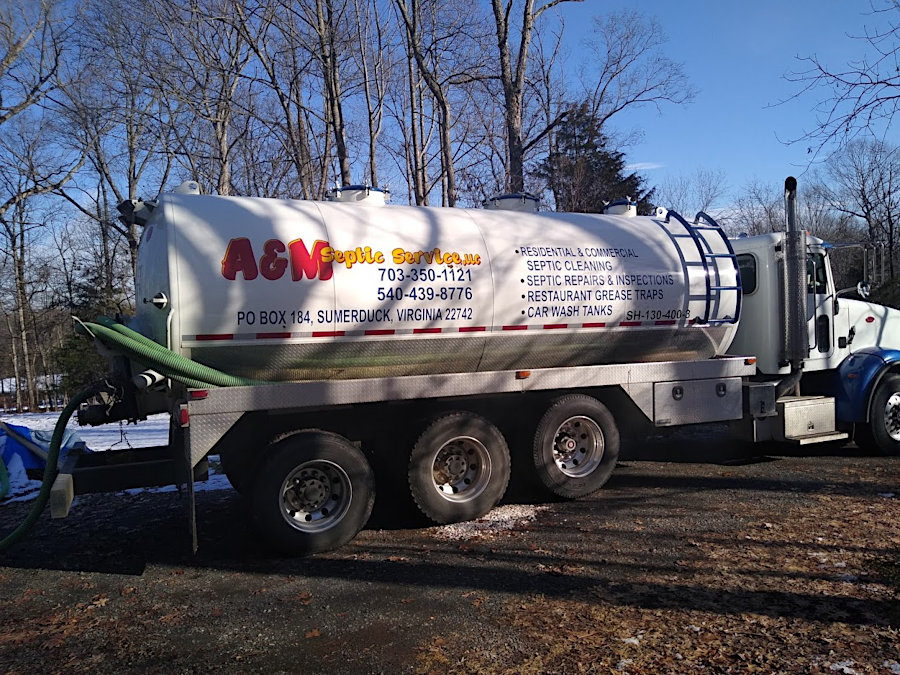
solids pumped from septic tanks are hauled away for treatment at large wastewater facilities
Aerobic bacteria decompose organic wastes in the liquid within the gravel and in a biofilm layer at the edge of the gravel-soil. Pathogens in the wastewater which manage to pass through the biofilm are eliminated by biological activity in the soil within a few feet of the gravel trench. Liquid entering a drainfield is a threat to human health, but by the time water from a drainfield reaches the surface it is not harmful - assuming the system is operating correctly.
Septic systems are classified as "failed" if they release inadequately treated water beyond the boundary of the drainfield, or at the surface of the ground. Failure may occur if the soil is not permeable enough. The liquid released from the pipes in the trenches needs to percolate past the gravel and move between soil particles. If there is too much clay in the soil blocking the flow, liquids may back up in the drainfield pipes and into the house.
Roots of plans, especially trees, can grow into pipes and block them. Drainfields are typically planted in grass and mowed in order to prevent tree roots from becoming a problem. Evidence of septic system failure is clear if someone flushes a toilet and septic fluid backs up enough to come out of the drain in a shower.
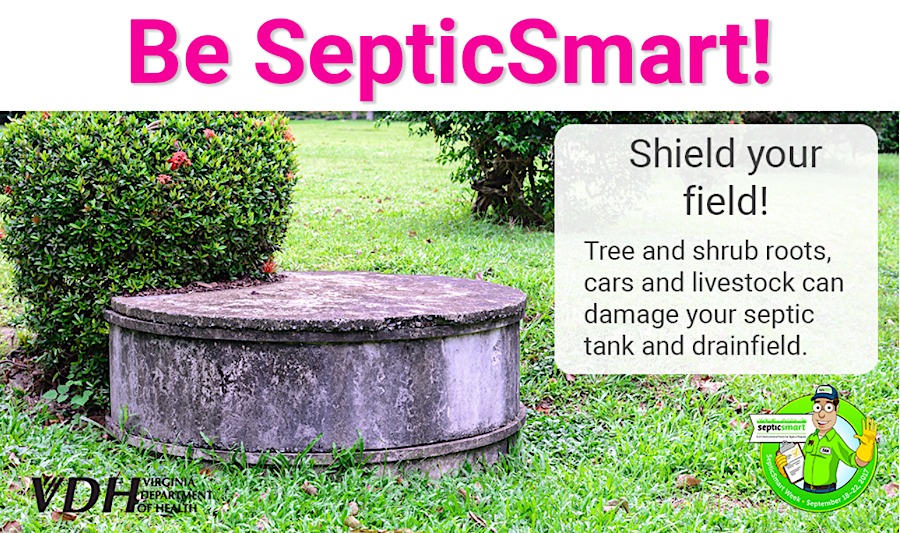
roots from trees and shrubs can block pipes, so most drainfields are covered in grass and mowed regularly
Source: Virginia Department of Health (VDH), SepticSmart Week
If the soil in a drainfield does not "perc" fast enough, perhaps because grease has flowed out of the septic tank and clogged the pores in the soil, liquids leaving the holes in drainfield pipes may rise up to the surface rather than sink down to the water table. Using a garbage disposal in the kitchen sink can create fine particles that do not settle in the septic tank, but instead flow while suspended into the drainfield pipes. Even if an effluent screen is added at the septic tank, those particles can reduce porosity in the soil and cause a septic system to fail.
Drainfields are sized for expected flow of liquid, 150 gallons per day per bedroom. The drainfield of a two-bedroom house is smaller than for a three-bedroom house. If bedrooms are to be added to a house with a septic system, then the drainfield usually needs to be expanded as well. In places where there is no suitable soil for a drainfield expansion, the local government will not issue a building permit for adding the extra bedrooms.4
Source: Virginia Department of Health, What to Know When Buying a Home with a Well and Septic System in Virginia
Septic systems can also fail if the drainfield pipes deliver carbon-rich nutrients faster than the aerobic bacteria in the trench can decompose the material into carbon dioxide and water. Where the flow saturates the soil and blocks access to oxygen on the bottom and sidewalls of the trench, anaerobic microorganisms can form a biomat where the gravel meets the soil. Slimy, jelly-like, layers of biomat are formed by a combination of undigested organic material and anaerobic bacteria. The anaerobic bacteria decompose organic material far slower than aerobic bacteria.
The biomat is basically impermeable. Instead of the wastewater liquids draining out of the drainfield pipes and through the trenches into the soil, the liquid can be trapped in the trenches. If a biomat ends up coating all the drainfield trenches, the liquid backs up into the pipes and the house and it becomes obvious that the wastewater treatment system has failed.
Pumping the septic tank will not solve the problem, other than to create storage space briefly to accommodate the wastewater created by a few showers. The cure is to allow regrowth of the aerobic bacteria, which will digest the biomat and restore permeability. If residents in a home reduce the flow of organic-rich fluids into the trenches, perhaps by taking a two-week vacation, then the aerobic bacteria can slowly repopulate the trenches and eliminate the biomat.
If a local jurisdiction will allow it, "greywater" from showers, sinks, and the washing machine could be diverted from the septic tank. Sending just the "blackwater" from the toilet will reduce the volume of liquid, enhancing access to oxygen for aerobic bacteria in the drainfield.5
If an extra number of people live in a house, then extra liquid waste will flow from showers/sinks/toilets into the septic tank. If too much fluid flows into drainfield pipes, then the bacteria may not have enough time to process the organic matter before it flow away from the pipes. That sort of failure can be revealed by an unpleasant smell where the groundwater flowing off the drainfield enters a stream.
If heavy equipment is driven across a drainfield, pipes buried just 6-12" underground can be cracked. If the soil in a drainfield is soft after rainstorms and horses walk through the field, a hoof can sink into the mud and crack a pipe. Cracked pipes release liquid quickly at the break when a toilet is flushed, rather than gradually through the holes in the pipes. When broken pipes release more fluid than can percolate through the soil, the surface of the ground above a broken pipe becomes soft and the smell of the unprocessed waste is often easy to detect.
Source: Environmental Protection Agency (EPA), Shield Your Field!
The Virginia Department of Health establishes standards for septic systems, and local officials require a "perc test" before authorizing construction of new houses that will rely upon a septic system. Two nearby parcels of undeveloped land may have dramatically different values, if the percolation test holes do not drain fast enough on just one of the parcels.
Sites with high groundwater levels, where the leachate leaving the pipes would reach groundwater before bacterial decomposition was completed, do not qualify for a septic system. Similarly, sites with too rapid a percolation rate (such as a sand dune or karst areas) or too little soil above bedrock also do not qualify.
The Virginia Department of Health estimates there are 1.1 million septic systems in the state. The first statewide database was not established until 2003, and the specific location of many pre-2003 drainfields is not documented.
Rising sea levels are causing old septic systems in Tidewater to fail. Groundwater levels are rising and septic tanks are flooding. When originally permitted, those systems met the standards - but conditions have changed over the last 50 years. The Middle Peninsula has gained a reputation as the "septic repair capital of the world." Roughly 4% of the nitrogen reaching the Chesapeake Bay comes from drainfields.
"Skip" Stiles of Wetlands Watch has warned that flooded septic systems are a precursor to flooded houses:6
In 2022 the Virginia Department of Health began a regulatory review of state regulations of septic systems. The review considered accounting for climate change. The state agency proposed that the 70 foot setback of conventional systems from waters with shellfish be increased to 100 feet, in areas that the Virginia Institute of Marine Sciences (VIMS) would map as "critical impact areas” which are most susceptible to flooding as sea level rises.7
In 1997, the General Assembly authorized alternative on-site septic systems. That change made it possible to build houses on parcels of land where a conventional system was not feasible. What were once unbuildable properties in areas with "blackjack" soils rich in clay, or in karst, became valuable homesites even though an alternative system could cost as much as $50,000.8
One of the common alternative on-site septic systems is a mound, a drainfield constructed above normal ground level with a pump to raise effluent up to the mound:9
Mounds and drainfields that require pumps, rather than rely upon fluid to flow by gravity, are useless if the electricity fails.
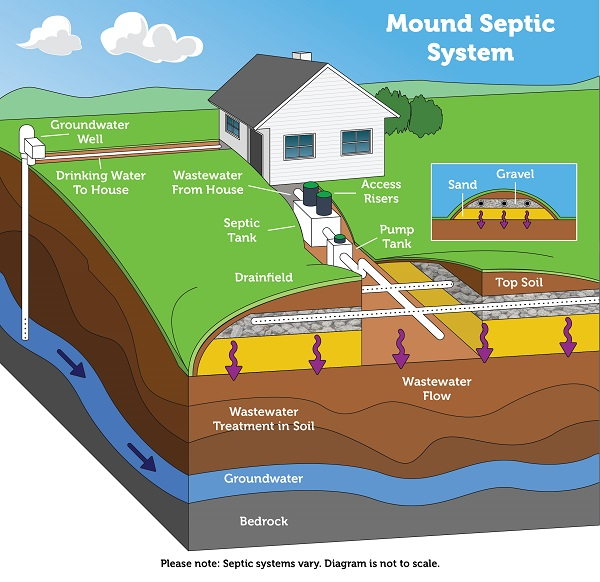
soil can be mounded to create enough volume to process liquid waste
Source: Environmental Protection Agency (EPA), Types of Septic Systems
/p>
In addition to a mound system, there are other alternatives to a standard septic tank and leach field. Air can be pumped into the septic tank, stimulating more digestion by microbes. If a storm interrupts electricity, however, the aerobic treatment system no longer works.
Plastic shields can be buried above the pipes in the leach field, rather than surround the pipes with gravel. The shields create aerobic chambers for the wastewater to interact with soil beneath plastic covers. With sand filters, wastewater passes through a septic tank to extract oils/grease and solids, and is then pumped into a chamber filled with sand. No leach field is required.
Pressurized dosing systems distribute effluent in scheduled packages through the leach field. That approach can minimize the risk of overloading the soil and having wastewater pool on the surface above the leach field pipes. A drip distribution/irrigation system, like a pressurized dosing system, also relies upon electricity to pump wastewater in measured increments through a leach field.
Wastewater discharge can also be designed so, after flowing through a septic tank and leach field, the effluent flows through a constructed wetland. Biological activity in the wetland reduces nutrients and "finishes" the treatment process.10
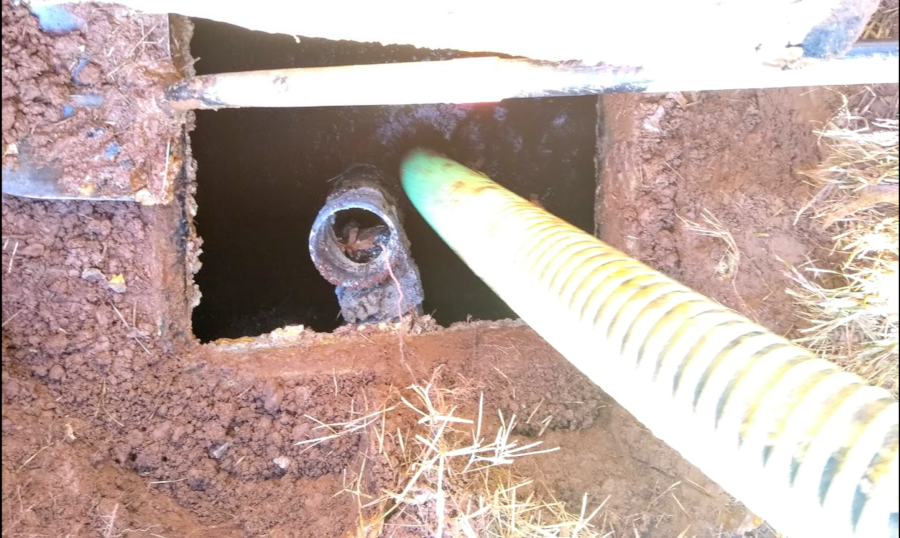
looking down into a septic tank, prior to pumping it out